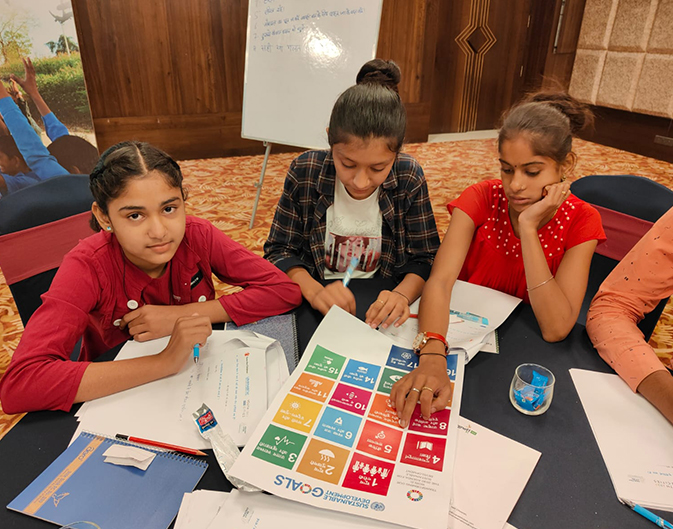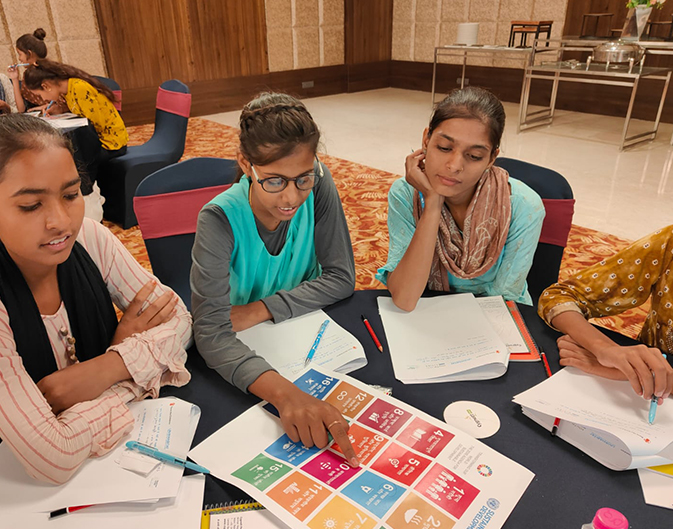Youth participation key to localising sustainable development goals in india
As we walked into a room full of familiar faces in Jaipur, we all realised we had grown in the past two years of the pandemic, when none of us were meeting. There was a time when trainings of all kinds would take place almost every day with children and youth. I remembered 17-year-old Vasundhara’s face immediately, I had the chance to photograph her in her village before the pandemic and now looking at that same face but marked by the trials of the pandemic, it was inspiring – she had become mature. Her group had travelled from the nearby district of Tonk where Bal Raksha Bharat has been working for almost a decade. We were also joined by a new group of young people from the slums of Jaipur for this particular training on Sustainable Development Goals (SDGs). This group had been working with a local NGO, World Vision, to eradicate child labour from their slums. All of us trainers were excited to see how the group mingles over the course of the discussions and forums designed for them.
Although the SDGs were set up in 2015, little has been done to localise the agenda at the grassroots level. As programming on ground becomes more participatory, it has been found that awareness alone cannot inspire active citizenship among the communities. As a country we must also assess if these efforts are penetrating the minds of those who are marginalised i.e those who can benefit most from these resources.

Bal Raksha Bharat believes that children and youth have the right to participate, as defined in the principles of the United Nations Convention on the Rights of the Child (UNCRC) Article 12. This convention establishes the right of every last child to participate and take decisions on their behalf, keeping their level of understanding and ability to participate in mind. Through the last 13 years in India, Bal Raksha Bharat has built their programming to establish children as the voice of the movement of child rights.
In June this year for project “Youth 2030” in partnership with UN Habitat and Healthy Cities for Adolescents, a Foundation Botnar initiative, a group of 50 child champions and youth advocates from Rajasthan came together to learn and engage with the Sustainable Development Goals. A few critical insights came to light.

Through the initial Focus Group Discussion, we found that there wasn’t much awareness of the SDGs among the children and youth in the age group of 15-24 years. Although most of the youth are actively working on social issues that they have identified, they haven’t been able to link them to the SDGs. However, there is a lot of ambition among the young people to reach out to more young like them, especially those who are marginalised and unable to access such resources or information.
We realised that young people feel that although the ambition of the SDGs is built for their future, they haven’t been involved from the beginning to assess the impact of the work so far. This gap needs to be addressed through localisation of the SDGs agenda and bringing forward the voices of youth that are most impacted by the issues the SDGs seek to report.

As part of the Youth 2030 training, we found that young people are eager to remove the middlemen in reporting of violations owing to the bureaucratic structures in place. Although they want to report and help monitor the SDGs, they feel that it needs to happen in a user and data friendly manner. Through the Youth 2030 project, UN Habitat is planning to use tech solutions to address the reporting issue. Young people brought out two main reasons why using an additional app may not be the best way and also suggested
1. In India, mostly the men in the family control smart phones and girls don’t have equal access: The young people suggested digital literacy and trainings for girls so that they too can access smart phones and make the most of them
2. The smart phones already have basic apps and data extension is expensive: If there was a way to integrate the reporting system in existing apps that would work for them much better. There are several tech solutions such as chat bots and internal linking that may help young people easily access the app, this can also be done through a website instead of an app according to them.
Children and youth also gave us feedback about how we can leverage strengths of the SDGs to localise the issues:
1. Leverage Relatability: The SDGs are very easy to understand, even those who may not be literate would be able to relate to them, and even a small child would be able to relate to them.
2. Engage Local Duty Bearers: We need to localise the SDGs with those people who are most marginalised but most importantly with the decision makers at the local level as well.
3. Include Parents: Localisation of SDG concepts with parents or working with School Management Committees or parent groups.
4. Show Big Picture: They saw that all the goals are linked to each other in a way that if one is focusing on one SDG, it’s imperative to keep others also in a bird’s eye view.
In conclusion, the Sustainable Development Goals need to be defined, implemented, and monitored with respect to local contexts, and we believe that youth are integral to this localisation. One of our Child Champions, Vasundhara, who is leading her own project in Tonk, Rajasthan, was particularly keen to talk about her aspirations to make an impact in society through continuous and dedicated work in her community. She said, “It was great to hear from people my age on the issues of urban slums in Jaipur, we want to join forces to find solutions keeping in mind the goals we need to reach by 2030.”
Written by
Sreepoorna Majumdar






